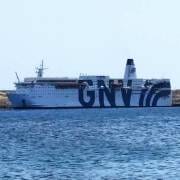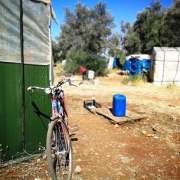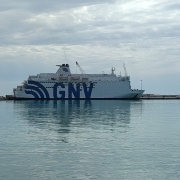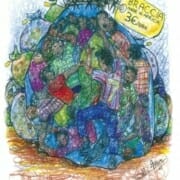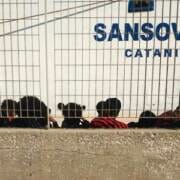The Hotspot Approach and Quarantine Ships
Article first published on December 9, 2021
Rivistailmulino.it – In the times of the pandemic, European border policy brings to light all the limits of an inadequate system marked by problems and especially by inhumanity.
At the beginning of the COVID-19 pandemic, we observed increasing stigmatization of foreign citizens who came to be seen as the primary carrier of the disease, whether they had been living in Italy for years or had been rescued from drowning in the Mediterranean. This perceived danger was also visible in European migration policy where we have seen increased institutionalized violence at Europe’s external borders. An example of this is the case of the March 2020 rejections at the Turkish-Greek border along the Evros River, where police shot at migrants trying to reach the other shore. Another example of increased violence is the isolation of people who entered to Europe irregularly. This stigmatization has to be seen in relation to the construction of a state of emergency. The trigger of this state of emergency is portrayed as unpredictable, on the one hand. On the other hand, it requires urgent action. But basically, European migration regulation has been subject to this logic of emergency already long before the pandemic.
The Hotspot Approach
Hotspots—quite literally hot spots—and corresponding measures to manage migration flows were introduced by the European Agenda for Migration (March 2015). As part of European migration policy, they are the lynchpin for managing migration flows that are currently not regulated by law and materialize the constructed state of emergency. These places are defined as “areas of the [EU’s] external borders affected by disproportionate migratory pressure.” They are also subject to direct intervention. Simultaneously, however, they do not feature much or at all in policy debates.
In recent years, hotspots fulfilled two main functions in Italy and Greece: the selection and restraint of unauthorized mobility. At the border, people are categorized by way of so-called screenings whereby they are first identified and photographed and subsequently questioned about their irregular stay on European soil. Based on this, a decision is made whether a person will go through the admission procedure as an asylum seeker or will be returned as an “economic refugee”. Our field research shows that the attributed nationality is the most important criterion in the selection process. Bilateral agreements between individual member states of the European Union and third countries allow for speedy repatriations. This procedure at the border puts into question the right to asylum of every individual.
This restraint mechanism manifests itself not only in the material impossibility of leaving the structure but also in its geographical location: a border — or rather a threshold — i.e. an area that is part of a sovereign state’s territory but where its laws do not apply. In fact, refugees are located in places at the EU’s external borders that are not accessible to anyone with the exception of a special permission. In Italy, this kind of special permission is granted by the Ministry of the Interior. Additionally, there is the special situation of the islands, such as Lampedusa or Lesbos, where the fact that it is hard to get away is used to discourage refugees from continuing their journey.
The hotspot approach was strategically necessary for the European border regime. Italy mainly focuses on selection, while Greece is predominately concerned with restraint. The hotspots on the Greek islands are used to prevent intra-European mobility in general. In Italy, the focus is more on controlling and selecting mobility by returning people as quickly as possible, especially Tunisian citizens.
In the midst of a pandemic and five years after the European Agenda for migration, a regulatory framework was presented on September 13, 2020. The EU Pact on Migration and Asylum continues to tighten the selection and restraint described. Similar to the pre-clearance checks already in place, especially pre-screening is supposed to bring forward and accelerate the decisions of border officials as to who is allowed to apply for asylum and who is classified as a so-called “economic refugee”. This process takes place at the external borders as these areas are not considered being already European territory — a gray area where the rule of law is suspended and to which third parties who could guarantee the people’s rights have no access.
The quarantine ships are another such place: A kind of floating border where migrants are detained immediately after arrival for the quarantine period.
Quarantine Ships
In addition to these already mentioned procedures, the Italian government now also uses quarantine ships, which are, by and large, another of these gray areas: a kind of floating border where migrants are detained immediately after arrival for the quarantine period. This arrangement is supposedly based on public health and emergency. Yet on closer look it is used to legitimize the increased confinement and isolation of migrants.
The declaration of a state of emergency at the beginning of the pandemic and the trans-ministerial decree by which the Italian authorities closed the ports were followed by a Civil Defence order on April 12, 2020. According to this order, ships are supposed to be used to quarantine those rescued at sea.
These emergency measures stipulate that the migrants will spend their isolation period in quarantine ships after their stay in the hotspot of Lampedusa, where they are identified and subjected to a health screening. In exceptional cases — that is, if the migrants are vulnerable persons or unaccompanied minors (UAM) — the isolation takes place in the departments of CAS*, CARA*, or a hotspot.
The ferries used for quarantining are chartered by the Ministry of Infrastructure from Gnv Spa and Moby Spa and are moored off the Sicilian ports of Lampedusa, Porto Empedocle, Palermo, Trapani, Augusta and Catania. They are in constant rotation, depending on the embarkation and disembarkation of the migrants beginning or ending their medical isolation. On board, the Italian Red Cross (Cri) is responsible for medical and psychological support as well as the identification of vulnerable people.
“Waiting leads to submission: […] this permanently alters, that is, as long as the expectation lasts, the behaviour of the person suspended from the expected decision.” [Pierre Bourdieu]
Staying on the ships can be extended beyond the ten days stipulated by law: risk of contagion, lack of available places in reception centers, and administrative deadlines are all factors that often prolong this status of being segregated. In this sense, detention on quarantine ships is a measure that only affects migrants: housed by the sea, at a place that is ‘outside’, separated from the mainland and that follows its own, externally determined temporal reality.
The Hotspot Approach on the Sea
On the quarantine ships, other procedures also take place besides the health ones. The “migration coordinator”, who is on board the ship and in contact with immigration officials, can modify the data of the registration form, which has been filled in the hotspot on Lampedusa during the identification process.
Seen from this perspective, arriving in Europe is a succession of selection and categorization processes. In the hotspot, people are categorized by nationality, age, and vulnerability: adults who have no noticeable health constraints are usually taken to the quarantine ships; UAM* or people identified as in need of protection are taken to quarantine centers on the mainland; on the quarantine ships — after being identified as being possibly vulnerable — a final selection is made.
The emergence of health concerns at the border has, consequently, aggravated as well as legitimized this practice of selection and illegal detention. This is done by systematically detaining people in border areas and confirmed cases of violating the right to personal freedom of movement and the fundamental rights to asylum, information, and health. (see Criticità del sistema navi quarantena per persone migranti: analisi e richieste; in Asgi, Diritti in rotta. L’esperimento delle navi quarantena e i principali profili di criticità, 2021).
In the case of people with Tunisian citizenship, who are systematically returned, an essentially already automated mechanism can be seen: from their arrival in Lampedusa to their stay on quarantine ships and their detention until deportation. This process has become more and more entrenched during this year of using quarantine ships.
In connection with such serious violations of rights, three people have lost their lives — Bilal Ben Massaud and minors Abou Diakite and Abdallah Said — whose health paradoxically deteriorated during their time on the quarantine ship.
It is thus possible to conclude that quarantine ships are in continuity with the hotspots’ function as a mechanism for selecting and restraining as described previously. The state of emergency imposed by the pandemic is being normalized and integrated into the usual regulations of arrivals.
The quarantine period, the geographical separation within isolation rooms, and the selection and channeling procedures are more useful for the government than for health care.
In this way, the medical surveillance regime, which decides on the arrival, identification, and categorization of people, does not only contribute to determining the administrative-legal paths of migrants but also to making expulsions and repatriations quicker and smoother – regardless of whether the fundamental rights of people are disregarded this way.
By Jacopo Anderlini and Silvia Di Meo
*CAS: Centro di accoglienza straordinaria – extraordinary reception center
*CARA: Centro di accoglienza per richiedenti asilo – reception center for asylum seekers
*UAM: unaccompanied foreign minor
Translated from German by Annika Schadewaldt




